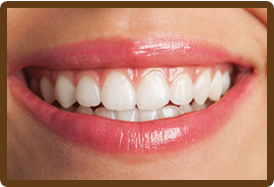COSMETIC DENTISTRY AT TRU DENTAL LAS CRUCES, NM
In the past decade there has been a dramatic interest in cosmetic dentistry. Here at Tru Dental we realize that having a healthy, bright, beautiful smile enhances our appearance and allows us to smile with confidence. Thanks to the advances in modern cosmetic dentistry, we are able to improve our teeth and smiles with quick, painless and surprisingly affordable treatments.
Cosmetic dental treatments can:
• Change the size, shape, and alignment of certain teeth.
• Fill in unattractive spaces between teeth.
• Improve or correct bites.
• Lighten or brighten the color of teeth.
• Repair decayed, broken, cracked, or chipped teeth.
• Replace missing teeth.
• Replace old, unattractive dental treatments.
Remember, your smile speaks before you even say a word!
Schedule an appointment today!
Chairside Economical Restorations of Esthetic Ceramic (CEREC®) has revolutionized dental procedures. Traditionally, if crowns, onlays, inlays or dental veneers were required to restore damaged teeth, multiple procedures and a great deal of waiting time in-between would be inevitable. CEREC® creates these ceramic restorations within minutes in the dental office. This means that many treatments can be completed in just a single visit.
CEREC® is comprised of several computer-assisted design (CAD) tools and a milling machine that creates custom ceramic restorative devices. CEREC® can make almost any ceramic restoration to order, meaning the dentist can place it immediately.
How can CEREC® benefit me?
CEREC® can benefit almost anyone needing a ceramic restoration. Exceptions include patients who have a prior history of breaking ceramic devices and those with a deep bite. CEREC® devices are proven to last for over 5 years, but recent research indicates that most CEREC®-created restorations last for more than 10 years.
Here are some other advantages associated with CEREC®:
- No temporary restorations.
- High-quality ceramic products.
- Minimal invasiveness.
- Less injections and discomfort.
- Fewer dental visits.
- Cost effectiveness.
- More natural tooth is saved.
- Long lasting restorations.
- Biocompatible solutions.
What is the CEREC® system comprised of?
The CEREC® System is sometimes called a CAD-CAM system. CAD-CAM means Computer Assisted Design and Computer Assisted Milling. The CEREC® system has three major components:
Acquisition device: This device is home to a high-quality camera and a medical grade computer. The function of this unit is to photograph the prepared tooth. Three-dimensional images are created of the tooth on the screen, which the dentist uses to design the perfect ceramic restoration.
Three-dimensional CAD software: This software allows the dentist to examine the tooth from every angle. It is the closest possible thing to holding the tooth in the hands and rotating it.
Milling device: This unit actually manufactures the custom restoration from the specifications entered into the computer. A ceramic block, which best resembles the existing tooth color is chosen and placed into the unit. Within minutes, the milling device produces the restoration the dentist designed. No horrible-tasting impressions or time-consuming transfers to and from the laboratory are required.
What does a CEREC® restoration procedure involve?
The first step in the procedure is to prepare the tooth. The dentist removes all tooth decay and shapes the tooth making it slimmer at the base. Next, an impression is made using a covering of titanium dust. This dust allows the camera to take a highly detailed picture of the tooth. Images are formulated with the CEREC® camera. CEREC® optical imaging utilizes an infrared wavelength.
The image is transposed onto the computer screen. It is here that the dentist is able to view the tooth from every angle and design the final restoration. When the design is complete, it is transmitted to the milling unit. The dentist chooses a block of ceramic that matches the color of the teeth. This ensures that the restoration will be very natural looking.
Within 15 minutes, the full crown, onlay, overlay or veneer is complete. The restoration is made of compressed, rather than laboratory-layered porcelain. This enhances strength and durability.
Before affixing the restoration to the tooth, the dentist will place it dry to ensure it fits perfectly. It is then polished and affixed to the tooth with dental cement. The procedure is now complete, and all without the need for a second visit! The quality of the results is the same as the laboratory-generated restoration, but a great deal of time and money has been saved.
If you have questions or concerns about CEREC®, please ask Dr. Trujillo or her team.
Dental implants are a great way to replace missing teeth and also provide a fixed solution to having removable partial or complete dentures. Implants provide excellent support and stability for these dental appliances.
Dental implants act as artificial roots (usually titanium) that are placed into the upper or lower jaw bone. Dr. Trujillo works with several oral surgeons and periodontists that surgically place the implant. Then, after the implant becomes stable in the bone, Dr. Trujillo can restore the implant screw with a restoration to look like a natural tooth. Teeth attached to implants are very natural looking and often enhance or restore the patient’s smile!
Dental implants are very strong, stable, and durable and will last many years, but on occasion will have to be re-tightened or replaced due to normal wear.
Reasons for dental implants:
- Replace one or more missing teeth without affecting adjacent teeth.
- Resolve joint pain or bite problems caused by teeth shifting into missing tooth space.
- Restore a patient’s confident smile.
- Restore chewing, speech, and digestion.
- Restore or enhance facial tissues.
- Support a bridge or denture, making them more secure and comfortable.
What does getting dental implants involve?
The process of getting implants requires a number of visits over several months.
X-rays and impressions (molds) are taken of the jaw and teeth to determine bone, gum tissue, and spacing available for an implant. While the area is numb, the implant will be surgically placed into the bone and allowed to heal and integrate itself onto the bone for up to six months. Depending on the type of implant, a second surgery may be required in order to place the “post” that will hold the artificial tooth in place. With other implants the post and anchor are already attached and placed at the same time.
After several weeks of healing the artificial teeth are made and fitted to the post portion of the anchor. Because several fittings may be required, this step may take one to two months to complete. After a healing period, the artificial teeth are securely attached to the implant, providing excellent stability and comfort to the patient.
Dr. Trujillo will provide care instructions when your treatment is completed. Good oral hygiene, eating habits, and regular dental visits will aid in the life of your new implant.
An inlay restoration is a custom made filling made of composite material, gold, or tooth-colored porcelain. Porcelain inlays are popular because they resemble your natural tooth. A porcelain inlay is made by a professional dental laboratory and is permanently cemented into the tooth by Dr. Trujillo.
Inlays can be utilized to conservatively repair teeth that have large defective fillings or have been damaged by decay or trauma. Inlays are an ideal alternative to conventional silver and composite fillings. Also, they are more conservative than crowns because less tooth structure is removed in the preparation of inlays.
As with most dental restorations, inlays are not always permanent and may someday require replacement. They are highly durable and will last many years, giving you a beautiful long lasting smile.
Reasons for inlay restorations:
- Broken or fractured teeth.
- Cosmetic enhancement.
- Decayed teeth.
- Fractured fillings.
- Large fillings.
What does getting an inlay involve?
An inlay procedure usually requires two appointments. Your first appointment will include taking several highly accurate impressions (molds) that will be used to create your custom inlay and a temporary restoration.
While the tooth is numb, Dr. Trujillo will remove any decay and/or old filling materials. The space will then be thoroughly cleaned and carefully prepared, shaping the surface to properly fit an inlay restoration. A temporary filling will be applied to protect the tooth while your inlay is made by a dental laboratory.
At your second appointment your new inlay will be carefully and precisely cemented into place. A few adjustments may be necessary to ensure a proper fit and that your bite is comfortable.
You will receive care instruction at the conclusion of your treatment. Good oral hygiene practices, a proper diet, and regular dental visits will aid in the life of your new inlay.
A composite (tooth colored) filling is used to repair a tooth that is affected by cavities (decay), cracks, fractures, etc. The decayed or affected portion of the tooth will be removed and then filled with a composite filling.
You and Dr. Trujillo can discuss the best options for restoring your teeth. Composite fillings, along with silver amalgam fillings, are the most widely used today. Because composite fillings are tooth colored, they can be closely matched to the color of existing teeth, and are more aesthetically suited for use in front teeth or the more visible areas of the teeth.
As with most dental restorations, composite fillings are not permanent and may someday have to be replaced. They are very durable, and will last many years, giving you a long lasting, beautiful smile.
Reasons for composite fillings:
- Chipped teeth
- Closing space between two teeth
- Cracked or broken teeth
- Decayed teeth
- Worn teeth
How are composite fillings placed?
Composite fillings are usually placed in one appointment. While the tooth is numb, Dr. Trujillo will remove decay as necessary. The space will then be thoroughly cleaned and carefully prepared before the new filling is placed. If the decay was near the nerve of the tooth, a special medication will be applied for added protection. The composite filling will then be precisely placed, shaped, and polished, restoring your tooth to its original shape and function.
It is normal to experience sensitivity to hot and cold when composite fillings are first placed, however this will subside shortly after your tooth acclimates to the new filling.
We will provide care instructions at the conclusion of your treatment. Good oral hygiene practices, eating habits, and regular dental visits will aid in the life of your new fillings.
A crown (or cap) is a covering that encases the entire tooth surface restoring it to its original shape and size. A crown protects and strengthens tooth structure that cannot be restored with fillings or other types of restorations.
Although there are several types of crowns, porcelain or ceramic (tooth colored) are the most popular. They are highly durable and will last many years, but like most dental restorations, they may eventually need to be replaced. Porcelain and ceramic crowns are made to match the shape, size, and color of your teeth giving you a natural, long-lasting beautiful smile.
Reasons for crowns:
- Broken or fractured teeth
- Cosmetic enhancement
- Decayed teeth
- Fractured fillings
- Large fillings
- Tooth has a root canal
What does getting a crown involve?
A crown procedure typically requires 1 to 2 appointments. Your first appointment will include taking highly accurate molds (or impressions) that will be used to create your custom crown. A mold will also be used to create a temporary crown which will stay on your tooth for approximately two weeks until your new crown is fabricated by a dental laboratory.
While the tooth is numb, Dr. Trujillo will prepare the tooth by removing any decay and shaping the surface to properly fit the crown. Once these details are accomplished, your temporary crown will be placed (if this is a 2-appointment procedure) with temporary cement and your bite will be checked to ensure you are biting properly.
At your second appointment your temporary crown will be removed, the tooth will be cleaned, and your new crown will be carefully placed to ensure the spacing and bite are accurate.
We will provide care instructions and encourage you to have regular dental visits to check your new crown.
A dental bridge is a fixed (non-removable) appliance and is an excellent way to replace missing teeth.
There are several types of bridges. You and Dr. Trujillo will discuss the best options for your particular case. The “traditional bridge” is the most popular type and is usually made of porcelain fused to metal. Porcelain fixed bridges are most popular because they resemble your natural teeth. This type of bridge consists to two crowns that go over two anchoring teeth (abutment teeth) and are attached to pontics (artificial teeth), filling the gap created by one or more missing teeth.
Dental bridges are highly durable and will last many years, however they may need replacement or need to be re-cemented due to normal wear.
Reasons for a fixed bridge:
- Fill space of missing teeth
- Maintain facial shape
- Prevent remaining teeth from drifting out of position
- Restore chewing and speaking ability
- Restore your smile
- Upgrade from a removable partial denture to a fixed dental appliance
What does getting a fixed bridge involve?
Getting a bridge usually requires two or more visits. While the teeth are numb, the two anchoring teeth are prepared by removing a portion of enamel to allow for a crown. Next, a highly accurate impression (mold) is made which will be sent to a dental laboratory where the bridge will be fabricated. In addition, a temporary bridge will be made and worn for several weeks until your next appointment.
At the second visit, you permanent bridge will be carefully checked, adjusted, and cemented to achieve a proper fit. Occasionally Dr. Trujillo may only temporarily cement the bridge, allowing your teeth and tissue time to get used to the new bridge. The new bridge will be permanently cemented at a later time.
We will provide care instructions at the conclusion of your treatment. Proper brushing, flossing and regular dental visits will aid in the life of your new permanent bridge.
Veneers are very thin pieces of durable, tooth shaped porcelain that are custom made (for shape and color) by a professional dental laboratory. They are bonded onto the front of teeth to create a beautiful and attractive smile.
Veneers can completely reshape your teeth and smile.
As with most dental restorations, veneers are not permanent and may someday need replacement. They are very durable and will last many years, giving you a beautiful long lasting smile.
Reasons for porcelain veneers:
- Cosmetically, to create a uniform, white, beautiful smile.
- Crooked teeth.
- Misshapen teeth.
- Severely discolored or stained teeth.
- Teeth that are too small or large.
- Unwanted or uneven spaces.
- Worn or chipped teeth.
What does getting porcelain veneers involve?
Getting veneers usually requires two visits to complete the process, with little or no anesthesia required during the procedure. The teeth are prepared by lightly buffing and shaping the surface to allow for the thickness of the veneer. A mold or impression of the teeth is taken and a shade (color) will then be chosen by you and Dr. Trujillo.
On the second visit the teeth will be cleansed with special liquids to achieve a durable bond. Bonding cement is then placed between the tooth and veneer and a special light beam is used to harden and set the bond.
Dr. Trujillo will provide care instructions for veneers. Proper brushing, flossing and regular dental visits will aid in the life of your new veneers.
Teeth whitening (or bleaching) is a simple, non-invasive dental treatment used to change the color of natural tooth enamel and is an ideal way to enhance the beauty of your smile.
Because having whiter teeth has now become the number one aesthetic concern of most patients, there are a number of ways to whiten teeth. The most popular method is using a home teeth whitening system that will whiten teeth dramatically. Since teeth whitening only works on natural tooth enamel, it is important to evaluate replacement of any old fillings, crowns, etc. Replacement of any restorations will be done after bleaching so they will match the newly bleached teeth.
Teeth whitening is not permanent. Touch-ups are needed to maintain the desired color and will vary depending on habits such as drinking coffee, tea, or wine or smoking.
Reasons for teeth whitening:
- Fluorosis (excessive fluoridation during tooth development)
- Normal wear of outer tooth layer
- Stained teeth due to medications (tetracycline, etc.)
- Yellow, brown stained teeth
You may experience tooth sensitivity during the time you are whitening your teeth, but it will subside shortly after you have stopped bleaching.
We will provide care instructions for your teeth and trays, and be encouraged to visit Dr. Trujillo regularly to help maintain a beautiful, healthy, white smile.















